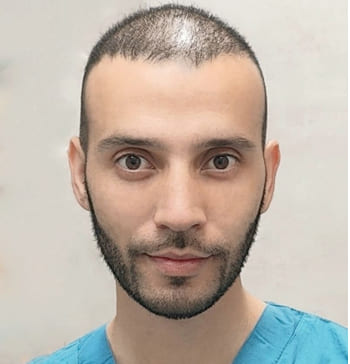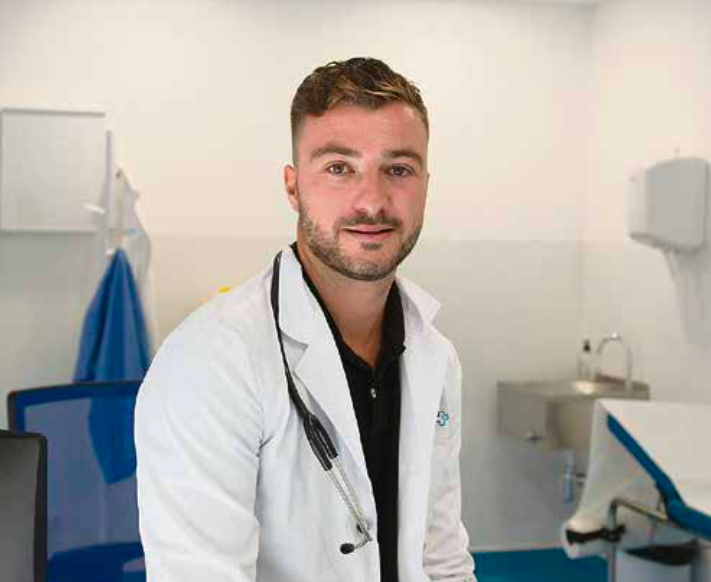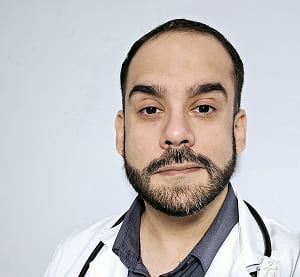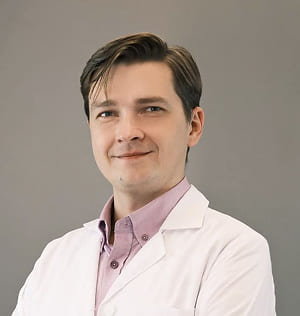
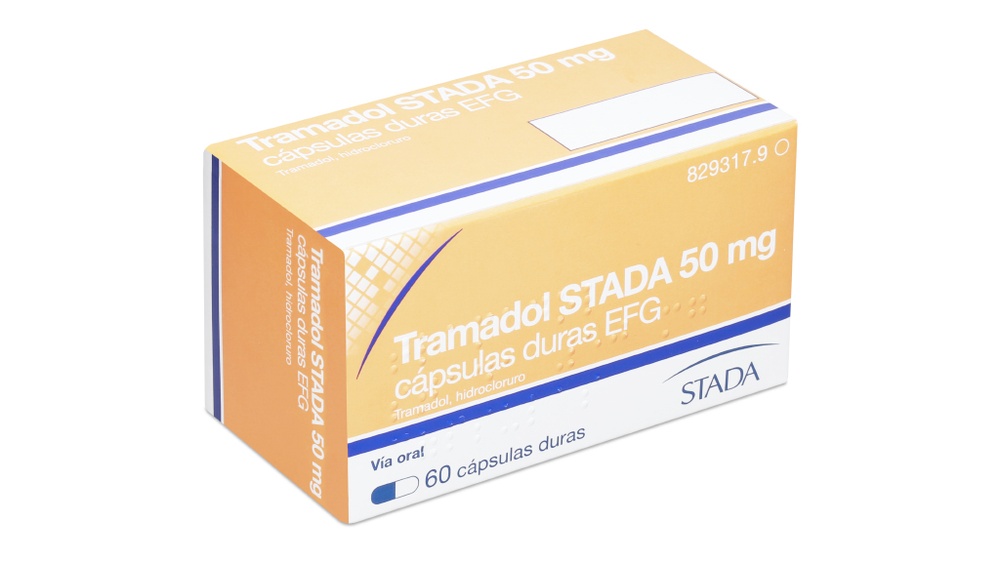
TRAMADOL STADA 50 mg HARD CAPSULES

Ask a doctor about a prescription for TRAMADOL STADA 50 mg HARD CAPSULES

How to use TRAMADOL STADA 50 mg HARD CAPSULES
Introduction
Package Leaflet: Information for the User
Tramadol Stada 50 mg Hard Capsules EFG
Tramadol, Hydrochloride
Read all of this leaflet carefully before you start taking this medicine because it contains important information for you.
- Keep this leaflet, you may need to read it again.
- If you have any further questions, ask your doctor or pharmacist.
- This medicine has been prescribed for you only. Do not pass it on to others. It may harm them, even if their signs of illness are the same as yours.
- If you get any side effects, talk to your doctor or pharmacist. This includes any possible side effects not listed in this leaflet. See section 4.
Contents of the pack
- What is Tramadol Stada and what is it used for
- What you need to know before you take Tramadol Stada
- How to take Tramadol Stada
- Possible side effects
- Storing Tramadol Stada
- Contents of the pack and other information
1. What is Tramadol Stada and what is it used for
Tramadol Stada is indicated for the treatment of moderate to severe pain.
2. What you need to know before you take Tramadol Stada
Do not take Tramadol Stada:
- if you are allergic to the active substance or any of the other ingredients of this medicine (listed in section 6).
- in situations of acute intoxication with alcohol, hypnotics, analgesics, opioids, or other psychotropic medications;
- if you are taking monoamine oxidase inhibitors (MAOIs), a certain type of medication for the treatment of depression, or if you have taken them in the last 14 days before treatment with tramadol (see "Taking Tramadol Stada with other medicines");
- if you have uncontrolled epilepsy;
- for the treatment of withdrawal syndrome.
Warnings and precautions
Consult your doctor or pharmacist before starting to take Tramadol Stada:
- if you think you are dependent on other potent analgesics (opioids);
- if you have a decreased level of consciousness (if you think you are going to faint);
- if you are in a state of shock (a sign of this state may be cold sweat);
- if you have increased intracranial pressure (e.g., after a head injury or diseases that affect the brain);
- if you have difficulty breathing;
- if you are epileptic or have a history of seizures, as the risk of seizures may increase;
- if you have any liver or kidney disease.
- tramadol should be used with caution if you have acute porphyria.
- if you suffer from depression and are taking antidepressants, as some may interact with tramadol (see "Other medicines and Tramadol Stada").
Seizures have been reported in patients taking tramadol at the recommended dose. The risk may increase when the dose of tramadol exceeds the maximum recommended daily dose (400 mg).
Tramadol is metabolized in the liver by an enzyme. Some people have a variation of this enzyme, and this can affect each person differently. In some people, sufficient pain relief may not be achieved, while others are more likely to experience serious side effects. If you notice any of the following side effects, you should stop taking this medicine and consult a doctor immediately: slow or shallow breathing, confusion, drowsiness, constricted pupils, general malaise, or vomiting, constipation, loss of appetite.
Consult your doctor, even if any of the above circumstances have occurred to you at any time.
Tolerance, dependence, and addiction
This medicine contains tramadol, which is an opioid medicine. Repeated use of opioids can make the drug less effective (the body gets used to it, which is known as pharmacological tolerance). Repeated use of Tramadol Stada can also lead to dependence, abuse, and addiction, which could result in a potentially fatal overdose. The risk of these side effects may be greater with higher doses and longer use.
Dependence or addiction can cause a feeling of lack of control over the amount of medicine you need to use or how often you need to use it.
The risk of dependence or addiction varies from person to person. The risk of becoming dependent on or addicted to Tramadol Stada may be greater if:
- You or any member of your family have abused alcohol or experienced dependence on it, prescription drugs, or illegal drugs ("addiction").
- You are a smoker.
- You have had problems with your mood (depression, anxiety, or personality disorder) or have been treated by a psychiatrist for other mental illnesses.
- If you notice any of the following symptoms while using Tramadol Stada, it could be a sign of dependence or addiction:
- You need to use the medicine for a longer period than indicated by your doctor.
- You need to use a higher dose than recommended.
- You are using the medicine for reasons other than those prescribed, for example, "to feel calm" or "to help you sleep".
- You have made repeated, unsuccessful attempts to stop using the medicine or control its use.
- You feel unwell when you stop using the medicine, and you feel better once you take it again ("withdrawal effects").
If you notice any of these signs, consult your doctor to determine the best course of treatment for you, when it is appropriate to stop the medicine, and how to do it safely (see section 3, if you stop taking Tramadol Stada).
Respiratory disorders related to sleep
Tramadol may cause sleep-related respiratory disorders, such as sleep apnea (pauses in breathing during sleep) and sleep-related hypoxemia (low oxygen level in the blood). Symptoms may include pauses in breathing during sleep, nighttime awakenings due to shortness of breath, difficulty maintaining sleep, or excessive daytime sleepiness. If you or someone else notices these symptoms, contact your doctor. Your doctor may consider reducing the dose.
Talk to your doctor, pharmacist, or nurse if you experience any of the following symptoms while taking tramadol:
Extreme fatigue, loss of appetite, severe abdominal pain, nausea, vomiting, or low blood pressure. These may be indicators of adrenal insufficiency (low cortisol levels). If you have these symptoms, contact your doctor, who will decide if you need to take hormonal supplements.
There is a slight risk that you may experience a serotonin syndrome that can occur after taking tramadol in combination with certain antidepressants or tramadol alone. Consult a doctor immediately if you experience any of the symptoms associated with this serious syndrome (see section 4 "Possible side effects").
Children and adolescents
Use in children with respiratory problems
Tramadol is not recommended for use in children with respiratory problems, as the symptoms of tramadol toxicity can worsen in these children.
Other medicines and Tramadol Stada
Tell your doctor or pharmacist if you are taking, have recently taken, or might take any other medicines.
Concomitant treatment with tramadol and monoamine oxidase inhibitors (MAOIs), a certain type of medication for the treatment of depression, should be avoided.
Both the effect and duration of pain relief produced by tramadol may be reduced if you take medicines that contain:
- Carbamazepine (for epilepsy).
- Ondansetron (to prevent nausea).
Your doctor will tell you if you should take tramadol and in what dose.
Concomitant use of tramadol with sedative medicines such as benzodiazepines or related drugs increases the risk of sedation, respiratory depression, coma, or even death. Due to this, concomitant use should only be considered when other treatment options are not possible. However, if your doctor prescribes tramadol with sedatives, the dose and duration of concomitant treatment should be limited by your doctor.
Tell your doctor about all sedative medicines you are taking and follow your doctor's dosing recommendations closely. It may be useful to inform friends or relatives so they are aware of the signs and symptoms indicated above. Contact your doctor when you experience these symptoms.
The risk of side effects increases,
- if you are taking tramadol simultaneously with tranquilizers, sleeping pills, other analgesics such as morphine and codeine (even when used for cough treatment), and alcohol. In these cases, you may feel drowsy or dizzy. If this happens, consult your doctor;
- if you are taking medicines that can cause seizures, such as certain antidepressants or antipsychotics. The risk of seizures increases if you take tramadol simultaneously with these medicines. Your doctor will tell you if tramadol is suitable for you.
- if you are taking antidepressants, tramadol may interact with these medicines, and you may experience a serotonin syndrome (see section 4 "Possible side effects").
- if you are taking anticoagulants such as acenocoumarol (Sintrom), as it may increase the risk of bleeding.
- if you take drugs that can increase the accumulation of tramadol and, therefore, its side effects (such as ritonavir, quinidine, paroxetine, fluoxetine, sertraline, amitriptyline, isoniazid, ketoconazole, and erythromycin).
- if you are taking gabapentin or pregabalin to treat epilepsy or pain due to nerve problems (neuropathic pain).
Taking Tramadol Stada with food and alcohol
Do not consume alcohol during treatment with tramadol, as alcohol can enhance the effects of tramadol. Food does not affect the effect of tramadol.
Pregnancy, breastfeeding, and fertility
If you are pregnant or breastfeeding, think you may be pregnant, or are planning to have a baby, ask your doctor or pharmacist for advice before taking this medicine.
There is very little information available on the safety of tramadol in pregnant women. Therefore, you should not use tramadol if you are pregnant.
Chronic treatment during pregnancy can cause withdrawal syndrome in the newborn after birth.
Tramadol is excreted in breast milk. For this reason, you should not take tramadol more than once during breastfeeding, or if you take tramadol more than once, you should interrupt breastfeeding.
Based on human experience, it is not suggested that tramadol affects fertility in men and women.
Driving and using machines
Ask your doctor if you can drive or use machines while taking tramadol. It is important that before driving or using machines, you observe how this medicine affects you. Do not drive or use machines if you feel drowsy, dizzy, have blurred vision, or double vision, or have difficulty concentrating. Be especially careful at the start of treatment, after a dose increase, after a change in formulation, and/or when administering it concomitantly with other medicines.
Tramadol Stada contains lactose and sodium
This medicine contains lactose. If your doctor has told you that you have an intolerance to some sugars, consult them before taking this medicine.
This medicine contains less than 1 mmol of sodium (23 mg) per capsule; this is essentially "sodium-free".
3. How to take Tramadol Stada
Follow exactly the administration instructions of this medicine given by your doctor. In case of doubt, consult your doctor or pharmacist again.
Before starting treatment and regularly during treatment, your doctor will also explain what you can expect from the use of Tramadol Stada, when and for how long you should use it, when you should contact your doctor, and when you should stop using it (see also section 2).
The dose should be adjusted to the intensity of the pain and your individual sensitivity. Normally, the lowest possible dose that produces pain relief should be used. Do not take more than 400 mg of tramadol hydrochloride per day, unless your doctor has instructed you to do so.
Unless your doctor has given you different instructions, the recommended dose is:
Adults and adolescents over 12 years
Normally, the initial dose is 1 or 2 tramadol capsules (equivalent to 50-100 mg of tramadol).
Depending on the pain, the effect can last between 4 and 6 hours.
Use in children
Tramadol is not recommended for children under 12 years.
Elderly patients
In elderly patients (over 75 years), the elimination of tramadol may be slow. If this is your case, your doctor may recommend prolonging the dosing intervals.
Patients with hepatic or renal impairment/patients on dialysis
If you have severe liver or kidney disease, treatment with tramadol is not recommended. If you have moderate liver or kidney disorders, your doctor may prolong the dosing intervals.
How and when should you take Tramadol Stada?
Tramadol capsules are administered orally.
Swallow the capsules whole, without dividing or chewing them, with sufficient liquid.
You can take the capsules with or without food.
For how long should you take Tramadol Stada?
This medicine should not be administered for longer than strictly necessary. If you require prolonged treatment, your doctor will monitor you at short and regular intervals (if necessary, with interruptions in treatment) to see if you should continue treatment with this medicine and at what dose.
If you think the effect of this medicine is too strong or too weak, tell your doctor or pharmacist.
If you take more Tramadol Stada than you should
If you have taken an extra dose by mistake, this will normally not have negative effects. You should take the next dose as prescribed.
After taking very high doses of tramadol, it can cause constricted pupils, vomiting, decreased blood pressure, increased heart rate, collapse, decreased level of consciousness up to coma (deep unconsciousness), seizures, and difficulty breathing that can lead to respiratory arrest. In this case, call a doctor immediately!
In case of overdose or accidental ingestion, go to a medical center or call the Toxicology Information Service, phone 91 562 04 20, indicating the medicine and the amount taken. It is recommended to bring the medicine leaflet to the healthcare professional.
If you forget to take Tramadol Stada
If you forget to take the medicine, it is likely that the pain will return. Do not take a double dose to make up for forgotten doses; simply continue taking tramadol as you have been doing until now.
If you stop taking Tramadol Stada
If you stop or finish treatment with this medicine too soon, it is likely that the pain will return. If you want to stop treatment due to side effects, consult your doctor.
Do not stop taking this medicine suddenly unless your doctor tells you to. If you want to stop taking your medicine, talk to your doctor first, especially if you have been taking it for a long time. Your doctor will tell you when and how to stop it, which can be done by gradually reducing the dose to reduce the likelihood of unnecessary side effects (withdrawal symptoms).
Generally, no side effects are experienced when treatment with tramadol is stopped. However, in rare cases, people who have been taking tramadol for some time may not feel well when stopping treatment abruptly. They may feel agitated, anxious, nervous, or have tremors. They may be overactive, have difficulty sleeping, or have digestion and bowel problems. Very few people suffer from panic attacks, hallucinations, unusual perceptions such as itching, tingling, numbness, and ringing in the ears (tinnitus). Very rarely, more unusual symptoms of the central nervous system have been detected, such as confusion, delirium, change in perception of personality (depersonalization), and change in perception of reality (derealization) and delusions of persecution (paranoia). If you experience any of these symptoms after stopping treatment with tramadol, consult your doctor.
If you have any other questions about the use of this medicine, ask your doctor or pharmacist.
4. Possible Adverse Effects
Like all medicines, this medicine can cause adverse effects, although not all people suffer from them.
You should consult your doctor immediately if you experience symptoms of an allergic reaction such as swelling of the face, tongue, and/or throat and/or difficulty swallowing and rash along with difficulty breathing.
The most frequent adverse effects during treatment with tramadol are nausea and dizziness, which occur in more than 1 in 10 people.
Very common: can affect more than 1 in 10 people
- Dizziness.
- Nausea.
Common: can affect up to 1 in 10 people
- Headache and numbness.
- Fatigue.
- Vomiting, constipation, and dry mouth.
- Sweating (hyperhidrosis).
Uncommon: can affect up to 1 in 100 people
- Effects on the heart and circulation (strong and rapid heartbeats, feeling of dizziness or collapse). These adverse effects can occur particularly in patients who are incorporated or who make physical effort.
- Desire to vomit (retching), gastrointestinal discomfort (e.g., feeling of fullness, heaviness), diarrhea.
- Skin reactions (e.g., itching, skin rash).
Rare: can affect up to 1 in 1,000 people
- Allergic reactions (e.g., difficulty breathing, wheezing, skin swelling) and shock (sudden circulatory failure) have occurred in very rare cases.
- Slow heartbeat.
- Increased blood pressure.
- Abnormal sensations (e.g., itching, tingling, numbness), tremors, epileptic seizures, muscle spasms, uncoordinated movements, transient loss of consciousness (syncope), speech disorders.
- Epileptic seizures occur mainly after taking high doses of tramadol or when taken simultaneously with another medicine that can induce them.
- Changes in appetite.
- Hallucinations, confusion, sleep disturbances, delirium, anxiety, and nightmares.
- Psychological changes may appear after treatment with tramadol. Their intensity and nature can vary (depending on the patient's personality and the duration of treatment). These can appear in the form of mood changes (usually euphoria, occasionally irritability), changes in activity (usually decreased and occasionally increased), and decreased cognitive and sensory perception (alterations of the senses and perception that can lead to errors of judgment).
- It can cause drug dependence. If tramadol is used for prolonged periods, it can produce dependence, although the risk is very low. When treatment is interrupted abruptly, withdrawal syndrome may appear (see "If you stop treatment with Tramadol Stada").
- Blurred vision, excessive dilation of the pupils (mydriasis), contraction of the pupils (miosis).
- Slow breathing, shortness of breath (dyspnea).
- Cases of worsening asthma have been reported, however, it has not been established whether they were caused by tramadol. If the recommended doses are exceeded or if it is taken concomitantly with other medicines that depress brain function, a decrease in respiratory frequency can occur.
- Muscle weakness.
- Difficulty or pain when urinating, less urine than normal (dysuria).
Very rare: can affect up to 1 in 10,000 people
- Increased liver enzymes.
Frequency not known: frequency that cannot be estimated from the available data
- Decrease in blood sugar levels.
- Hiccup.
Indeterminate frequency (cannot be estimated from the available data)
Serotonin syndrome, which can manifest as changes in mental state (e.g., agitation, hallucinations, coma), and other effects, such as fever, increased heart rate, unstable blood pressure, involuntary muscle contractions, muscle stiffness, lack of coordination, and/or gastrointestinal symptoms (e.g., nausea, vomiting, diarrhea) (see section 2 "What you need to know before taking Tramadol Stada").
Reporting of adverse effects:
If you experience any type of adverse effect, consult your doctor or pharmacist, even if it is a possible adverse effect that does not appear in this prospectus. You can also report them directly through the Spanish Pharmacovigilance System for Human Use Medicines: https://www.notificaram.es. By reporting adverse effects, you can contribute to providing more information on the safety of this medicine.
5. Conservation of Tramadol Stada
Keep this medicine out of sight and reach of children.
Store this medicine in a safe and protected place, where others cannot access it. This medicine can cause serious harm and even be fatal to people who have not been prescribed it.
This medicine does not require special storage conditions.
Do not use this medicine after the expiration date that appears on the packaging and the blister after CAD. The expiration date is the last day of the month indicated.
Medicines should not be thrown away through the sewers or in the trash. Deposit the packaging and medicines you no longer need in the SIGRE Point of the pharmacy. In case of doubt, ask your pharmacist how to dispose of the packaging and medicines you no longer need. This way, you will help protect the environment.
6. Package Contents and Additional Information
Composition of Tramadol Stada
- The active ingredient is tramadol hydrochloride. Each capsule contains 50 mg of tramadol hydrochloride.
- The other components are: lactose monohydrate, microcrystalline cellulose, sodium starch glycolate (type A), magnesium stearate, povidone K 30.
Composition of the capsule shell: gelatin and titanium dioxide
Appearance of the Product and Package Contents
Tramadol Stada 50 mg are hard gelatin capsules. They are available in packages of 20, 60, and 500 capsules.
Only some package sizes may be marketed.
Marketing Authorization Holder and Manufacturer
Marketing Authorization Holder
Laboratory STADA, S.L.
Frederic Mompou, 5
08960 Sant Just Desvern (Barcelona)
Spain
Manufacturer
Toll Manufacturing Services, S.L.
Aragoneses, 2
28108 Alcobendas (Madrid)
Spain
Date of the Last Revision of this Prospectus:May 2024
Detailed and updated information on this medicine is available on the website of the Spanish Agency for Medicines and Health Products (AEMPS) http://www.aemps.gob.es/

How much does TRAMADOL STADA 50 mg HARD CAPSULES cost in Spain ( 2025)?
The average price of TRAMADOL STADA 50 mg HARD CAPSULES in November, 2025 is around 2.5 EUR. Prices may vary depending on the region, pharmacy, and whether a prescription is required. Always check with a local pharmacy or online source for the most accurate information.
- Country of registration
- Average pharmacy price2.5 EUR
- Active substance
- Prescription requiredYes
- Manufacturer
- This information is for reference only and does not constitute medical advice. Always consult a licensed doctor before taking any medication. Oladoctor is not responsible for medical decisions based on this content.
- Alternatives to TRAMADOL STADA 50 mg HARD CAPSULESDosage form: ORAL SOLUTION/SUSPENSION, 100 mg/mlActive substance: tramadolManufacturer: Grünenthal Pharma S.A.Prescription requiredDosage form: INJECTABLE, 100 mgActive substance: tramadolManufacturer: Grünenthal Pharma S.A.Prescription requiredDosage form: CAPSULE, 50 mgActive substance: tramadolManufacturer: Grünenthal Pharma S.A.Prescription required
Alternatives to TRAMADOL STADA 50 mg HARD CAPSULES in other countries
The best alternatives with the same active ingredient and therapeutic effect.
Alternative to TRAMADOL STADA 50 mg HARD CAPSULES in Polonia
Alternative to TRAMADOL STADA 50 mg HARD CAPSULES in Ucrania
Online doctors for TRAMADOL STADA 50 mg HARD CAPSULES
Discuss dosage, side effects, interactions, contraindications, and prescription renewal for TRAMADOL STADA 50 mg HARD CAPSULES – subject to medical assessment and local rules.


